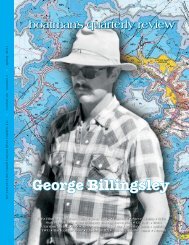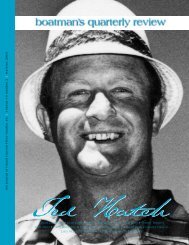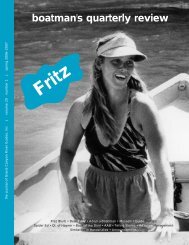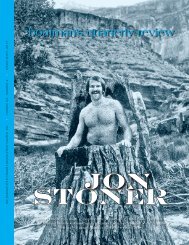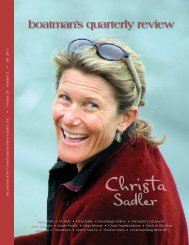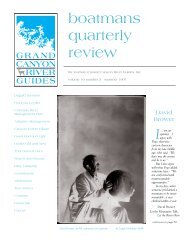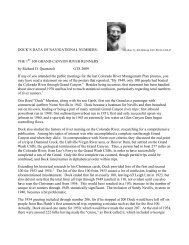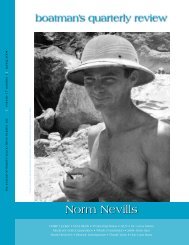They’d knock him down, they didn’t even take it easyon him! They hit him with his leg. They’d pull it off ofhim and hit him with it!Steiger: Who was doing that?<strong>Billingsley</strong>: O’Connor Dale. Oh, my God, he wascrazy too. So, we were playing basketball, and somehowI just happened to get Ron with a body block just right,and he flew up in the air and went in one of the roomsand landed on a bed… just floored him. So the nextmorning he came in and said, “If you want to run a boatfor me, you can run a boat.”Steiger: It was after that, huh?<strong>Billingsley</strong>: Yeah.Steiger: Had he been resisting or anything?<strong>Billingsley</strong>: No, I don’t think so. George had askedhim, and he was thinkin’ about it.Steiger: But he made up his mind when youknocked him right on the bed?<strong>Billingsley</strong>: I guess so. So that was the end of theseason.Steiger: That would have been the end of ’74 then?<strong>Billingsley</strong>: And if there’s one thing that’s consistentabout me, is that whenever I think I’m doin’ prettygood, I do somethin’ really stupid.Steiger: Like on the river, you mean.<strong>Billingsley</strong>: Anywhere… So that’s what I did on theriver, too, my first trip: I hung up in Badger Rapid, allnight long.Steiger: A little too far to the right?<strong>Billingsley</strong>: Yeah. I mean, you couldn’t have endedup on it any better. Did you know Mary Beth Riffey?She was married to John Riffey. She did bird studies outat Toroweap. She was my helper. It was my first timewith a boat, so what I was doin’ was, I was goin’ downempty, with George and another boatman, and then Iwas gonna pick up a bunch of bellhops from Las Vegas.Helicopter in and go from Lava, down. So I was empty. Ijust totally missed it. I went in there and drove right upon the rock. When I realized I was messing up, insteadof turning the boat, I put it in reverse. Ended up sidewayson the rock, just sitting there with Mary Beth andI. It was like, “Oh, my God, I can’t believe it.” It was soembarrassing.Steiger: So what did those guys do?<strong>Billingsley</strong>: There was nothing they could do. Theytried. They were both through the rapid. So Mary Bethand I tried everything. I tried pulling the side tube offand letting it drag us off. That didn’t work. We triedpulling ropes out, and that didn’t work. And then I hadto just sit there while dory trips and oar trips went by.The next day… Well, Bob Dye, who hadn’t ever beenon the river, had hiked out to the rim—because he wasone of the guys that hiked with us all the time, too—towatch us go through. And when he saw me hang up, hehiked down Jackass <strong>Canyon</strong>. And then he hiked backout and told Ron Smith.Steiger: Oh, great!<strong>Billingsley</strong>: And luckily—very luckily—Ron Smithhad just sneaked down the canyon with this big boat hehad built, and these huge inboard motors. What was thename of that boat? I can’t think of it.Steiger: Is it the Brandy Jo? Was that the one?<strong>Billingsley</strong>: Well he got stuck down there. And hegot in big trouble with the Park Service. He did it thatvery spring.Steiger: He was with somebody who told me thatstory once. So he was in a forgiving mood?<strong>Billingsley</strong>: He was, thankfully. But his brother,Mark, was there. So Mark came down in a Sport Yak,the next day. I’ll tell ya’, in May, if you spend a night onthe river, it’s cold. It was so cold in the middle of thatrapid. Anyway, Mark came down the next day, and justas the SportYak hit us, he jumped on the boat. TheSportYak got sucked underneath, buoyed the boat up,and we’re off in ten minutes.Steiger: That wasn’t what he planned on doin’, wasit?<strong>Billingsley</strong>: No. But he thought it might work. Heactually thought it might work, and it did work. Mostly,he was just tryin’ to get on the boat to help us.Steiger: But once it went under there… He knew itwas gonna go under there?<strong>Billingsley</strong>: Yeah, he knew it was goin’ under, hewas ready to jump as soon as it hit. Yeah, Mark Smith.So then he went on down with us and hiked out atLava. And then by that time I had gotten my acttogether and was able to do it.Steiger: So then he kind of coached you and stuff?<strong>Billingsley</strong>: Yeah, gave me a little more help. I wasfine after that.Steiger: Boy, that must have been hard.<strong>Billingsley</strong>: That was hard.Steiger: Did you get any of this, “Oh, they shouldn’tlet a woman be a boatman,” from those guys?<strong>Billingsley</strong>: No, I never heard… I’m sure there wasa lot of it, but nobody ever said anything to me. Theywere very nice. It wasn’t the last time I did somethin’stupid like that. When we were in low water, it musthave been seventy—well, that whole time we wererunning…Steiger: That whole year was a really low-water year.<strong>Billingsley</strong>: It was horrible. The next year we wentdown, it was so low, and we got down to Hance. We gotthere, and there were a bunch of oar boats, everybodywas deciding if they were gonna camp there ’til thewater came up, or try and get through before it got toolow. They all decided to go for it. I’m going, “George,this is not a good idea.” My helper, again, was MaryBeth Riffy. So they hiked all the people around, and wewent through. I made the cut around that big—andpage 32grand canyon river guides
At the Little Colorado <strong>River</strong> – July 5, 1976.right up onto that red rock, just right between the twoframes. And there I sat. It was like (whispers), “I can’tbelieve I did this again!” Mary Beth is goin’, “<strong>Susan</strong>, arewe stuck again?” “Yes, Mary Beth.”Steiger: Well, that’s easy to do.<strong>Billingsley</strong>: But I’ll tell you, I said, “There’s no wayin the world I’m gonna spend another night in a rapid.”So I took off—we had a center tube across there—climbed down in there, and thought, “I need somethingto pry this boat off this rock.” So I got table legs, andstarted jackin’ that thing up, and workin’ it, and workin’it. It started giving a little bit. But the water was dropping.I thought, “Oh, my God, I can’t…” So I got MaryBeth on the engine, and she would run the engine, andfinally I got it up, and it came off.Steiger: Did you have to jump out of the middle atjust the right time on that?<strong>Billingsley</strong>: Well, as soon as it went, I was out ofthere, and then went back to the engine, and the lowerunit was burned up by that time, just trying to get off. Sowe got through the rapid, but without an engine—andthen changed the engine.I was probably, to be perfectly honest, not the bestboatman on the river. I made it through, I made itthrough in really low water. I did okay, but I was lucky alot. Went through a lot of engines down there.Steiger: So you ran a boat for a couple years? Wasthere a high point, do you remember? When you lookback on it.<strong>Billingsley</strong>: You know, the high point for me wastaking people down the river that had never doneanything like that, and showing them a really good time.That was really important to George and me. That’swhat we were there for. He wanted to teach peoplegeology. And the nice thing—you know, I’ve done someoar trips—but the nice thing about motor trips is thatyou can do a continuous education with the people allthe way down the river. On oar trips, they change boats.Each boatman gives them a little something, but on amotor trip, with just two boatmen and all the people,you can make a continuous story as you go down theriver, and have it all hooked together. Much better thanyou can on an oar trip, I think.Steiger: I think you’re right. Now, did you guys usedto have people change boats? Or did people usually geton one boat and stay there?<strong>Billingsley</strong>: Yeah, but we always came together andtied up for a lot of the talks. And we floated a lottogether. We did a lot of floating on the river… And Ithink we did really good trips. Of course I think thepeople were a little different back then too. They didn’texpect as much on a trip. They hadn’t heard all of theirneighbors say what they had done on a trip and what toexpect. So it was a real adventure for ’em. They wereboatman’s quarterly review page 33
- Page 1: the journal of Grand Canyon River G
- Page 4 and 5: FarewellsHenry Quayle, 1946-2007Exc
- Page 6: Guide ProfilesClint Spahn, Age 19Wh
- Page 9 and 10: Matt Fahey / faheyfoto.comboatman
- Page 11 and 12: Barclay Trimble served as the recre
- Page 13 and 14: Egg DayI was up early a hectic daya
- Page 15 and 16: With one of the first copies of thi
- Page 17 and 18: Company, the authors—who happen t
- Page 19 and 20: scree slope and the angle mellows a
- Page 21 and 22: survive. Some of these plants need
- Page 23 and 24: flashlight, hoping there are no rea
- Page 25 and 26: Tempest”Matt Fahey / faheyfoto.co
- Page 27 and 28: up—where you start at that canyon
- Page 29 and 30: Steiger: What year was that?Billing
- Page 31: saying, “Sue, are you warm enough
- Page 35 and 36: Susan, Ryan, and Marijka, family bo
- Page 37 and 38: iver. We had it figured out, and th
- Page 39 and 40: Matt Fahey / faheyfoto.comboatman
- Page 41 and 42: R.I.P. Shorty—Forty Years LaterOn
- Page 43 and 44: Carl & Marge BoyerHjalmar BrantingJ
- Page 45 and 46: Grand Canyon River Guides, Inc.Prof
- Page 47 and 48: 2007 GCRG T-Shirts AvailableThe 200




